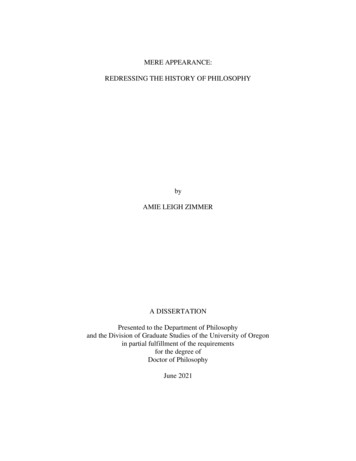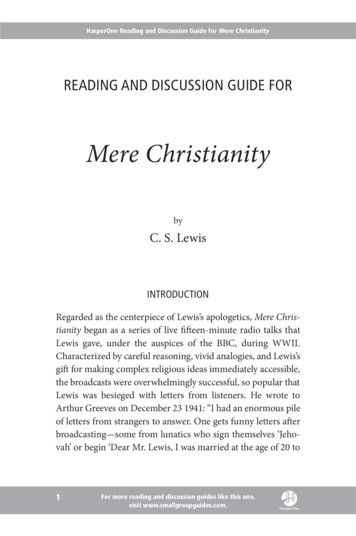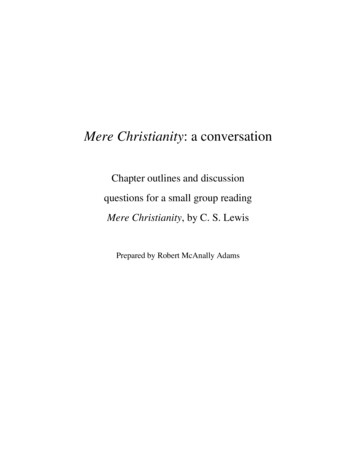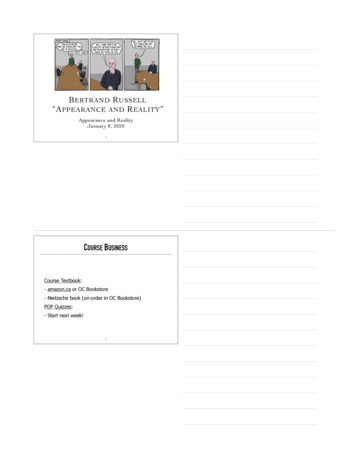
Transcription
MERE APPEARANCE:REDRESSING THE HISTORY OF PHILOSOPHYbyAMIE LEIGH ZIMMERA DISSERTATIONPresented to the Department of Philosophyand the Division of Graduate Studies of the University of Oregonin partial fulfillment of the requirementsfor the degree ofDoctor of PhilosophyJune 2021
DISSERTATION APPROVAL PAGEStudent: Amie Leigh ZimmerTitle: Mere Appearance: Redressing the History of PhilosophyThis dissertation has been accepted and approved in partial fulfillment of therequirements for the Doctor of Philosophy degree in the Department of Philosophy by:Beata StawarskaBonnie MannRocío ZambranaKate MondlochChairpersonCore MemberCore MemberInstitutional RepresentativeandAndrew KardunaInterim Vice Provost for Graduate StudiesOriginal approval signatures are on file with the University of Oregon Division ofGraduate Studies.Degree awarded June 2021ii
2021 Amie Leigh ZimmerThis work is licensed under a Creative CommonsAttribution-NonCommercial-NoDerivs (United States) Licenseiii
DISSERTATION ABSTRACTAmie Leigh ZimmerDoctor of PhilosophyDepartment of PhilosophyJune 2021Title: Mere Appearance: Redressing the History of PhilosophyThe principal aim of this dissertation is to seriously consider what accounts of fashionand dress can offer—have indeed already offered—to philosophy. In recounting thesehistories, I have two primary goals. The first is to show that, despite the breadth of primaryliterature on the subject, fashion and dress have not been meaningfully taken up as sites ofcontinuing philosophical inquiry. The second is to provide a foundation upon whichcontinuing work on the subject may be done in the discipline of philosophy. Regarding thefirst, it will be my contention throughout the dissertation that the philosophical disregard forfashion can indeed be accounted for on philosophical grounds.There are two primary motives accounting for fashion remaining in philosophy’scloset: 1) the metaphysical subordination of appearances to essences; and 2) the feminizationof fashion, and subsequent subordination of the feminine within philosophy. It is my viewthat the “feminization” of fashion, or the designation of clothing as a uniquely feminineconcern, has perpetuated its erasure as a meritorious topic of philosophical concern.The five major chapters of the dissertation can be divided into two thematic sections.Section I comprises Chapters II, III, and IV, and centers on the project of “recovery,” orrather, the project of “raiding” philosophy’s closet for new (old) tools to wield in thedevelopment of a philosophy of fashion. Section II analyzes just some of the social andiv
political implications of a metaphysical schema in which clothing is made to be “only” or“merely” about the world of appearances.v
CURRICULUM VITAENAME OF AUTHOR: Amie Leigh ZimmerGRADUATE AND UNDERGRADUATE SCHOOLS ATTENDED:University of Oregon, EugeneNew School for Social ResearchUniversity of New MexicoDEGREES AWARDED:Doctor of Philosophy, 2021, University of OregonMaster of Arts in Philosophy, 2015, New School for Social ResearchBachelor of Arts (Philosophy and English, Double Major), 2012,University of New MexicoAREAS OF SPECIAL INTEREST:History of Philosophy, Continental Philosophy, Feminist PhilosophyPROFESSIONAL EXPERIENCE:Instructor of Philosophy, Seattle University, 2020-PresentGraduate Employee, University of Oregon, 2015-2020GRANTS, AWARDS, AND HONORS:Award for Best Submission by a Graduate Student, “Kant’s Conjectures: theGenesis of the Feminine,” Society for Phenomenology & ExistentialPhilosophy (SPEP), 2020Departmental Nomination for Graduate Teaching Excellence Award, Universityof Oregon, 2020Departmental Research Fellow, University of Oregon, Fall 2019Gary E. Smith Summer Professional Development Award, University of Oregon(Graduate School), 2019Graduate Teaching Fellowship, University of Oregon, 2015-2020vi
Outstanding M.A Graduate Award, New School for Social Research, 2015PUBLICATIONS:Zimmer, Amie Leigh. Forthcoming. “Rethinking the Right to Health: Ableismand the Binary Between Individual and Collective Rights.” Bioethics.Zimmer, Amie Leigh. Forthcoming. “Husserl, Beauvoir, and the ‘Problem’ of theSexes” Simone de Beauvoir Studies.Zimmer, Amie Leigh. Forthcoming. “Ontological Fabric: Eugen Fink’s CriticalPhenomenology of Fashion” in Eugen Fink: Ethics, Metaphysics,Ontology, ed. By Iulian Apostolescu. Berlin: De Gruyter.Zimmer, Amie Leigh. 2020. “Feminism and Fashion.” American PhilosophicalAssociation (APA) Blog Series on Women in Philosophy. Online on-and-philosophy/.Zimmer, Amie Leigh. 2020. “Fichte’s Existential Logic.” Journal of SpeculativePhilosophy. 34(2): 201-223.Zimmer, Amie Leigh. 2018. “The Logic of the Mask: Nietzsche’s Depth asSurface.” The Agonist: a Nietzsche Circle Journal, Vol. XII (1).Zimmer, Amie Leigh. 2016. Book Review of Lived Experience from the InsideOut: Social and Political Philosophy in Edith Stein (2014).Phenomenological Reviews. Online access.vii
ACKNOWLEDGMENTSThis work is indebted to the friends, colleagues, and mentors who have supported,listened, believed, pushed, and guided. I am a richer, fuller version of myself having beenpart of this department and this community. I am grateful to the members of this committeefor never questioning whether the work belonged in the Department of Philosophy. Instead,they have all pushed and encouraged the project, and me, to explore this exciting terrain. Iam grateful to my aunt, who I call Veve, whose passion for literature inspires my own.Finally, I am grateful to my mother: for her vigilance of my wellbeing, limitless supply oflove and support, boundless and beautiful care, and fervent trust and belief in me.viii
For my mom. Te iubesc.ix
TABLE OF CONTENTSChapterPageI. INTRODUCTION: FASHION AND PHILOSOPY .1The Metaphysical Subordination of Appearances to Essences .6The Feminization of Fashion .25Outline of Chapters .37SECTION I: A HISTORY OF (FASHIONABLE) IDEASII. THE THEOLOGY OF CLOTHING .43Kant’s Conjectures .46Levinas, Shame, and the Feminine .59Dressing Differently.70III. FASHION AND (HISTORICAL) MATERIALISM80Diderot, the Dressing Gown, and Embodied Materialism .83Marx, Fashion, and Dialectics .93Benjamin, (Fashion) History, and (Evolutionary) Progress. 101IV.EUGEN FINK: THE PHENOMENOLOGIST OF FASHION . 117Historical Context and the Reception of Mode . 119Fink on Kant and Nietzsche . 126The Depth of Surface: Fink on Fashion . 130Clothing and the Lived Body . 143x
ChapterPageSECTION II: ADDRESSING AND REDRESSING THE MEANING OF CLOTHINGV. The Naturalization of Clothing . 150Clothing, Naturalization, and Criminality . 155Clothing and Coloniality . 166Liberal “Values” and Naturalization . 175VI. Recovering Our Clothes . 186Recovering a Sense of Clothing with Husserl and Merleau-Ponty . 188Hyle (Matter), Sensations, and Imagination . 189Depth and Style . 197The Pleasure of Clothes: Young and the Phenomenological Tradition . 204VII. CONCLUSION . 221REFERENCES CITED . 225xi
“Philosophy again and again finds itself in pursuit of the real truth hidden behindthe merely apparent, taking thought to discover what is as opposed to what seemsto be the case, and confident that the wisdom worth loving will endure.Philosophy may, then, take itself to have a natural antagonism to fashion, as wellas a perfect antipathy to any interest in clothes—those wrappings of thewrappings of the mind—those superficial goods situated at least two removesfrom reality, from the philosopher’s perdurable realm of ideas.”—Karen Hanson,“Dressing up, Dressing Down: The Philosophic Fear of Fashion”“How, then, comes it, may the reflective mind repeat, that the grand Tissue of all Tissues, theonly real Tissue, should have been quite overlooked by Science—the vestural Tissue, namely, ofwoollen or other Cloth; which Man’s Soul wears as its outmost wrappage and overall; whereinhis whole other Tissues are included and screened, his whole Faculties work, his whole Self lives,moves, and has its being?”— Thomas Carlyle, Sartor ResartusI. INTRODUCTIONFASHION AND PHILOSOPHYIntroductionA philosophical history of fashion has been long in the making, or fashioning. FromDiogenes to Diderot, Benjamin to Barthes: philosophers of all stripes have given in tofashion’s pull and have attempted to reconcile its ever-changing, ephemeral nature with thephilosophical search for wisdom: less ephemeral, more a priori. In recounting many of thekey moments and thinkers of this history throughout the dissertation, I will show thatanalyses of fashion and clothing alike have produced insights central to the theories andframeworks of the thinkers I focus on throughout. In other words, my principal aim is toseriously consider what accounts of fashion and dress have to offer—have indeed alreadyoffered—to philosophy. In recounting these histories, I have two primary goals: the first isto show that, despite the breadth of primarily literature on the subject, fashion and dresshave not been meaningfully taken up as vital sites of continuing philosophical inquiry. The1
second is to provide a foundation upon which continuing work on the subject may be donein the domain of philosophy. In regards to the first, it will be my contention throughout thedissertation that the philosophical disregard for fashion can indeed be accounted for onphilosophical grounds.There are two primary motives which account for fashion remaining inphilosophy’s closet: 1) the metaphysical subordination of appearances to essences; and 2)the feminization of fashion, and subsequent subordination of the feminine withinphilosophy. It is my view that the “feminization” of fashion, or the designation of clothingas a uniquely feminine concern, has perpetuated its erasure as a worthy candidate forphilosophical inquiry. I understand “feminization” itself as roughly synonymous with theconcern for, or love of the world of appearances that has itself been denigrated throughoutthe history of philosophy. I thereby take the “feminization” of fashion as an extension ofthe subordination of appearances to essences I track in the first major section of thisintroduction. The dissertation’s major chapters will both account for and work to disruptthese two suppositions.Before detailing each chapter in detail, I will first attend to these two majormotivations in respective sections. Before detailing the relevant metaphysical history in thefirst section, it is worth saying a few things here about how I conceive of and treatmetaphysics as a feminist philosopher. A critical stance towards metaphysics adopted byfeminist philosophers in particular is based on an “argument that [metaphysics] ispolitically pernicious,” as Johanna Oksala puts it (2016, 22). The argument is as follows:“Metaphysics should be resisted because it masks an effective ideology of oppression. Asnumerous feminist thinkers have demonstrated, the devalued side of each ontological2
suppositions as mind/body, nature/culture, reason/emotion, and animal/human, forexample, has been attached to femininity and this has led to and upheld oppressive practicesand conceptions about women” (22). But challenging, let alone changing social realityinvolves disputing the naturalization of binaries, hierarchies, and conceptions of (human)nature which rely on metaphysical paradigms that have for long—that continue to—privilege certain categories over others. I take there to be a critical difference between aproject of feminist metaphysics and that of feminine metaphysics. Whereby the formerchallenges the naturalization of biases and prejudice as unchangeable or immutable “facts”about human nature (as essences of human nature), the latter merely reverts the problematicdualisms that feminist metaphysics, and feminist philosophy more generally, takes issuewith from the beginning. My aim in laying out this distinction is to situate my own projectsquarely with the former, not the latter.The femin-ist challenge to metaphysics is in its criticism of the history ofmetaphysics as being immune or immutable to social and historical forces, as well as in itshighlighting of the relevance of bias and prejudice in perpetuating naturalized metaphysicaltruths and dualisms. In other words, it is not that immutable truths dictate “natural”hierarchies among persons, but that bias and prejudice fuel the justification ofnaturalization with an appeal to the metaphysical. I understand feminist metaphysics itself,then, as a methodological “undoing” of the reign of the metaphysical a priori: specifically,its function to instantiate and re-instantiate metaphysical “truths” about—for example, andof special interest for my project here—sexed and gendered differences in particular.Therefore, my “method” is to trace the history of metaphysics in order to redress it byarguing throughout the dissertation that the “universal truths” upheld by metaphysics have3
in fact been conditioned by bias and prejudice alike. In detailing what I call thesubordination of appearances to essences throughout this first major section of this chapter,my aim is to “set the stage,” so to speak, for my dissertation’s challenge to thissubordination.But what is metaphysics if not, well, metaphysical? In other words, how is afeminist metaphysics possible?1 Here I follow both Christine Battersby (1998) and JohannaOksala (2011; 2016), who each develop a “new” metaphysics borne out of their respectivecritiques of metaphysics as both universalizing and ahistorical. For instance, Battersbyproposes feminist metaphysics as a project of recovery by suggesting that metaphysics isnot a monolithic tradition with a set canon. Battersby’s aim is to re-place women inmetaphysics in a dual sense: first, by arguing that their elision in the history of metaphysicshas been intentional but is not necessary for a functional metaphysics; and second, bythinking metaphysics anew from the place of the female-subject position (cf. 1998, 2). Asto the former, Battersby writes that in the history of western metaphysics, woman havebeen seen as “fall[ing] outside ‘essence’—or the defining characteristics of a species orthing—in ways that have been supposed to make it a mistake to look for an essence offemale nature or experience” (1). In terms of the latter, Battersby writes: “I am not positingan ‘other’ form of subjectivity which is that of the ‘feminine’ or ‘female’ subject. Instead,I am asking what happens if we model personal and individual identity in terms of thefemale” (2).Like Battersby, I contend that “woman” has been excluded from the history ofWestern metaphysics, and that she has been intentionally and willfully constituted as mereThis question alludes to Johanna Oksala’s chapter title of the same name. See “How is Feminist MetaphysicsPossible” in Feminist Experiences (2016).14
appearance: understood, as Battersby puts it, as “unrepresentative of that distinctive,underlying ‘essence’ of humanity that philosophers have associated with ‘truth’” (cf. 1998,1). Unlike Battersby, however, I do not seek to “model” identity on either female orfeminine subjectivity. Instead, I employ a similarly deconstructive approach to the historyof Western metaphysics in order to expose long-maintained prejudices for the sake ofexcavating and cultivating a philosophy of fashion: a topic which Battersby pays no mindto as a meaningful part of—a meaningful force of—the perpetuation of the metaphysicaldualisms and subsequent domination/subordination dyad she sets out to revert.Johanna Oksala concentrates—more concretely than does Battersby—on thelinguistic dimension of metaphysics, or, on the histories, effects, and influences oflanguage and syntax on metaphysics, and vice versa. As Oksala puts it: “ it is vital thatany attempt to construct an alternative metaphysics responds to this challenge adequately”(2016, 29). Following Foucault, Oksala suggests that a feminist metaphysics must considerthe “strong emphasis on the historical, social, and political aspects of the constitution ofreality” emphasized by the linguistic turn (29). Language, in other words, is not only orjust “an abstract grid of intelligibility,” but a “social and historical practice incorporatingpower relations” (30). Bracketing the issue of Foucault’s commitment or non-commitmentto metaphysics, Foucault (at the very least) denies any conception of metaphysics asidentifying “universal structures of reality” (32). Conducting an ontology of the present,opposed to an ontology in general or as such, historicizes and politicizes metaphysics alikeby rendering it vital to the project of problematization: to the “possibility of contesting andtransforming ontology understood as the sedimented and normally taken-for-grantedbackground” (33). As Oksala puts it, the politicization of ontology is not merely a process5
of “unmasking,” but of “redescription” or rewriting (33).2Like Oksala, I take (feminist) metaphysics to be commensurate with the project ofa (feminist) ontology of the present. In other words, the project of a feminist metaphysicsis to unmask and redescribe the taken-for-granted which, in turn, displays both thecontingency and historicity of metaphysical schemas. In their understanding ofmetaphysics and metaphysical schemas as both situated and historical, I follow bothBattersby and Oksala. However, rather than turning to Foucault as Oksala does, my methodbears more similarities to that of Battersby, who mines the history of philosophy foralternative readings of identity that would normatively resituate metaphysics as beginningwith woman, and not treating her as “phenomenal” or as “mere appearance.” My project,however, does not have the same normative impulse. Instead of mining, I raid the historyof philosophy’s proverbial closet in order to prepare for a new avenue of philosophicalinquiry: that of philosophy’s relationship to fashion and clothing.The Metaphysical Subordination of Appearances to EssencesBeginning with Plato, the mimetic paradigm maintains that “truth” or essence is locatedbeyond the world of appearances in a metaphysical or transcendental world of ideal forms(cf. Plato 2001; cf. Beistegui 2012). While by no means the only trajectory in the historyof metaphysics, the Platonic schema remains a dominant one: worth interrogating for itsenduring force and influence. With Plato, the world of appearances becomes a world of2While she says little of the historical a priori in her discussion of feminist metaphysics, it is worth notingthe conceptual identification that is actually taking place. In order to excavate or to problematize an ontologyof the (historical) present, one must employ a conception of the a priori as equally historical (cf. Foucault2002). For further discussions of the historical a priori, see Allen and Aldea’s edited collection on the subject(2016), particularly their introduction (Allen and Aldea 2016) and Carr (2016).6
“mere” appearances: the incorrect (or false) realm of philosophical judgment. In John 7:24,Jesus implores his followers to “stop judging by mere appearances, but instead judgecorrectly.” The charge of judging by mere appearances comes from a Biblical distinctionbetween the human and the divine: while human persons “look at the outward appearance,”the Lord “looks at the heart,” because he “does not look at the things people look at” (1Sam 16:7). From a Biblical perspective, then, remaining in the world of appearances istantamount to rebuking the divine, since judging others by their “mere appearance” is away of feeling righteous without actually being righteous, i.e. without truly following thewisdom of God. Just as Biblically “correct” judgment involves going beyond the judgmentof appearance, philosophically “correct” judgment, too, often involves a forsaking of theworld of appearances for the metaphysical or for the ideal. Inward essence (or the divine)is traded in philosophy for the metaphysical.Appearances are made to be “mere,” or insufficient, when they becomesubordinated to a deeper, “truer” reality than that which we encounter through appearances.The distinction inaugurated a metaphysical and philosophical trajectory whereby the searchfor wisdom and truth necessarily subordinates the world of appearances for that of anotherworld or realm. The subordination is significant, for it signals that a bias against aestheticsis in fact built into the pursuit of metaphysics. Even Platonic and Aristotelian inquiries intoaesthetics—a domain in which discussions of fashion would seemingly reign—subordinatethe aesthetic to the metaphysical in such a way that confirms this bias as a structuralcomponent of a long-reigning metaphysical method.3 Book 7 of Plato’s Republic is3Despite important differences between Plato and Aristotle, scholars like Miguel Beistegui maintain that thePlatonic schema holds out. Aristotle’s subversion of the imagic from a source of skepticism to a source oflearning and potential truth nonetheless maintains wedded to the minimally dualistic structure between thesensible and the intelligible. That is, even though mimesis functions pedagogically for Aristotle, it always7
infamous for its depiction of the “Allegory of the Cave,” where the shadows on the cave’swalls represent the appearances that are not to be trusted: the images that exist not only asmere appearances, but as shadows of the real, later conceived in more detail in Book 10 asthe “original.” There, Socrates ponders the work of art as a special kind of image. But,special as it is, the work of art is still thematized in the language of deception, conceivedthere as imitation or mimesis (μίμεσις). In the Sophist, Plato writes that certain images mayresemble the originary truth from which they exist as mere derivatives, and these imagesin particular may even be able to act as a ladder between appearance and essence,essentially capitulating to the same pedagogical function as the cave’s shadows (2015, 1289). As Julia Kristeva writes of Plato’s Cave in Intimate Revolt: “ trapped by deception,sensation for Plato is necessarily false, for it is always subordinated and flawed in relationto the intelligible” (2003, 53). In the Republic, the figure of Socrates warns not only againstimages, but of the “luxurious city”—what he calls the “fevered state”—characterized by“the manufacture of all kinds of articles that have to do with women’s adornment” (1963,619). In his plight against physical desire, the body, and sensation more broadly, Socratesinsists that philosophers keep their distance from “smart clothes and shoes and other bodilyornaments” (1963, 47).Aristotle departs from Plato in subverting the image from a source of skepticism(as it is in Plato’s “Allegory of the Cave”) to a source of learning and site of potential truth.Despite this, however, he remains committed to the minimally dualistic structure forged byPlato between the sensible and the intelligible, conceived in Aristotle as the distinctionbetween hyle and morphe, or between form and matter (Aristotle 1992; cf. Aristotle 1996,points beyond the object it imitates. This renders “truth” as located in the intelligible realm only, whileappearance remains “merely” sensible (cf. Bestegui 2012).8
6). Aesthetic objects may be a source of knowledge themselves for Aristotle, whodistinguishes between knowledge of “matter” and knowledge of “forms” (cf. 1992, 27-28).However, all art is itself guilty of a fundamental mimesis: of “imitating” nature (Aristotle1992, 27). Even the pleasure derived from art, and the “knowledge” one might attain fromit, is itself dependent, on Aristotle’s account, on having some prior familiarity with—someimplicit or a priori understanding of—that which is being represented. As he writes in thePoetics, people “take delight” in seeing images because “what happens is that as they viewthem they come to understand and work out what each thing is (e.g. ‘This is so-and-so’).If one happens not to have seen the thing before, it will not give pleasure as an imitation,but because of its execution or colour, or for some other reason” (1996, 6). As John Sallisputs it, on Aristotle’s account “one can learn through the image only if it is recognised asan image of the thing itself” (1995, 177). In other words, the image or aesthetic object isnot taken on its own terms, but always subordinated to its original or originary essence orform.Kant concedes, as did Plato and Aristotle, that learning happens primarily, or atleast initially, by imitation. Kant decries mimesis as a subordinate form of aestheticpursuit, writing in the Critique of Judgment that genius is “entirely opposed to the spirit ofimitation” (2001, 187). Aristotle wrote that human beings have “a strong propensity toimitation and in learning their earliest lessons through imitation,” and Kant that “learningis nothing but imitation” (1996, 6; 2001, 187). For Kant, imitation is “on the natural pathof inquiry,” but is by no means its height (187). In the Critique of Judgment, the beautifulgives way to the understanding that there exists a power of judgment with its owncorresponding principle: the principle of judgment. The judgment of the beautiful—9
especially of nature—is in a very necessary sense the access point to the principle ofjudgment: a threshold to an understanding of judgment as a faculty in itself. Whilejudgments of the beautiful refer to objects that exist in nature, judgments of the sublimeonly refer to that which exists in the mind (2001, §27-8, 140-8). Importantly, beauty is a“symbol” of morality which gives morality its sensible form only (2001, §59, 225-228).Symbols for Kant are “representations based on mere analogy” (226). As such, theyconstitute a realm of mimetic appearances. Beauty, contrasted with reason for Kant,becomes feminized (cf. Gatens 1991; Klinger 1997; Mann 2006). Kant writes that “to findperfection in a thing requires reason and to discover beauty in it requires nothing butmere reflection (without any concept) on a given representation” (2001, 310). The“purposiveness of form in appearance is beauty” (48). The purposiveness of form inappearance is a contrast to the purposiveness of the faculty of reason. As I will argue ingreat detail in Chapter II, the process of reason’s ascension (in its full realization of itself)is not a sex or gender-neutral one, and reason (sexed male and gendered masculine) isindeed catalyzed or propelled up the ladder on account of Eve’s folly in the Garden ofEden. In feeling shame and covering herself up with the original clothing—that tiny figleaf—reason is able to direct itself away from “instinct” (sexual temptation) and come intoits own as a properly human faculty, separate from the animal (for whom instinct reigns,on Kant’s view) (cf. 1786/1999, 224). Aesthetic representations therefore only serve, asKant writes, “contingent” rather than essential functions: means to reason’s ultimate end(cf. 2001, 49).Even though human beings only ever experience mere appearances for Kant, andnot things as they are in themselves, Kant conceptualizes the faculty of reason in terms10
which dislocates “truth” from their phenomena (1999, 104). 4 The developmental (orepigenetic) account of reason proffered by Kant creates a hierarchy which subordinatesappearances to the “understanding,” not unlike the Platonic “ladder” or the Aristotelianclaim that pleasure in aesthetic objects is really, or truthfully, a pleasure of theunderstanding. In the Critique of Pure Reason, Kant conceived of himself as departingfrom a Platonic metaphysics that split sensibility from intelligibility by positing that it isnot possible for human persons to have a priori knowledge of the intelligible world, for itis a world completely independent to the human mind (1999). However, Kant replaces theworld of Platonic forms with reason, and the first critique is especially concerned with thepossibilities of human reason to have a priori knowledge. Metaphysics thereby becomesin Kant the “inventory of all we possess through pure reason” (1998, 104). As I will arguein Chapter II through a novel reading of Kant’s “Conjectures on the B
A critical stance towards metaphysics adopted by feminist philosophers in particular is based on an "argument that [metaphysics] is politically pernicious," as Johanna Oksala puts it (2016, 22). The argument is as follows: "Metaphysics should be resisted because it masks an effective ideology of oppression. As










